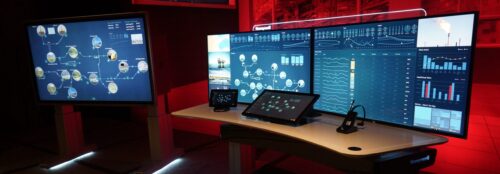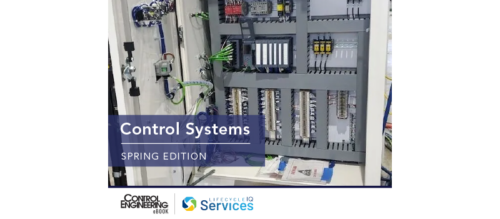Schematic software enables productive designs
This additional exclusive online material is a companion to the cover article in the February 2003 Control Engineering.Click here to return to the main article
This additional exclusive online material is a companion to the cover article in the February 2003 Control Engineering. Click here to return to the main
Xbox contract manufacturer Flextronics saves by using Microsoft Visio
GM chooses Eplan as its CAE standard
Users comment on ECT promis-e
VIA Development users provide additional comments
Eplan 21 Modules comprise the Engineering Suite
Eplan 21 features
Screen illustration gallery
There’s a lot to say about innovations related to today’s schematic software packages. The following material provides additional insights into electrical computer-aided design (CAD) or computer-aided electrical (CAE) design software, which simplifies wiring layouts, lowers design and development costs and decreases training time for those using it.
Xbox contract manufacturer Flextronics saves by using Microsoft Visio
With more than 70,000 employees worldwide, and design, engineering, manufacturing, and logistics operations in 28 countries, Flextronics Corp. (Singapore www.flextronics.com) provides extensively computerized and automated contract electronics manufacturing services. Products include the Microsoft Xbox video game system.
META Group Consulting (Stamford, CT www.metagroup.com) recently interviewed 10 Microsoft Visio users at Flextronics (including 9 technical professionals) to determine what they need in a diagramming tool, how well Visio fulfills their needs, how they use Visio in the manufacturing process, and how they communicate worldwide using Visio diagrams.
Since using Visio, the Flextronics employees interviewed have experienced a 125% average increase in effectiveness, a 109% average increase in efficiency, a 72% average increase in clarity, and a 69% average increase in accuracy. Six of 10 use it weekly, and 3 of 10 use it daily. Seven of 10 said design was the most critical area of value; 2 of 10 said brainstorming and documenting were the most critical area of value.
Luis J. Velez, a Flextronics system administrator in charge of one of the shop floors, saves 120 hours a month using Visio flowcharts to analyze processes, assist in quality assurance testing, assemble the shop floor, and define rules for repair routes. Omar Palacios, system administrator, uses Visio diagrams for process flow development, manufacturing route development, implementation, documentation, and planning. Says Mr. Palacios, ”With Visio, I can do in 30 minutes what used to take two days.”
Process engineers at Flextronics use custom Visio shapes to quickly design efficient process flows and production line layouts. These workers can simulate production lines that meet customer production requirements and eliminate potential bottlenecks before production lines are put in place.
Enterprise solution engineers use Visio project schedules, data flow diagrams, process flow diagrams, and network diagrams to model the Flextronics Manufacturing Enterprise System, which tracks operational information for existing production lines and uses control points to give management feedback on how smoothly a production line is running. Visio diagrams serve as a communication tool across the enterprise to capture and maintain information for IT reports distributed to various departments.
Software developers use Visio to automatically model databases from the custom machine, control point, station flow capacity shapes and data stored with the shapes in all these Visio diagrams, making it feasible to visualize data relationships, faster to implement databases, and easier to maintain a database interface to the manufacturing floor.
Since using Microsoft Visio, the Flextronics employees interviewed have experienced a 125% average increase in effectiveness (with a range of 40 to 400%), a 109% average increase in efficiency (with a range of 15 to 400%), a 72% average increase in clarity, and a 69% average increase in accuracy. Seventy percent of the Flextronics interviewees say Visio is most valuable to them in their design tasks, followed by brainstorming and documenting tasks. Eighty percent of interviewees create two to four diagrams each month, and many more during peak project periods.
Kulvinder Lall, project manager, who uses Visio for her design tasks, says the diagramming software increases accuracy so she can ”get it right the first time.” Lall works with project teams to create high-level process flow diagrams for management. She goes into more detail with each department project team to map the logical aspects of the process. Then she maps the physical processes for line workers and creates functional specifications that cover the flow of information from the production line to the databases for the developers-all using Visio. The greatest benefit of Visio, Lall says, is in ”designing and mapping shop floor control systems from a physical stand-point-what users have to do at each step in the process.”
She adds, ”I can’t imagine doing my job without Visio. It’s a cleaner and easier way to create and present process flows. Once we’re done with the mapping, that’s what we develop. The func-tional specifications are derived directly from the process maps.”
Manufacturing Enterprise System Lead Gus Shahin describes how he works with Visio to quickly design and map processes: ”I typically go to a production line and assess the process requirements-for example, process flow, quality, etc. I set up the process in Visio and determine where the control units need to be. I rework the process with the teams and use initial high-level diagrams to get management buy-in. I then develop the processes in more detail for implementation in MES. Visio is used as the design tool for designing and mapping the process.”
When asked what benefits he associates with Visio, Shahin says, ”Designing a process is easy to do graphically. I can create high-level diagrams to convey the basic design for presentations to management and get initial buy-in. Then it is easy to increase the level of detail during the implementation process for each department.” He adds, ”I have been using Visio for three to four years, and it keeps getting easier.”
Development director, Roger Yang, has noticed productivity increases since using Visio: ”Visio is very important in database and software design. It enables everyone to have input and makes it easy to communicate and share information. It greatly improves our productivity.” Visio is an ”open platform system,” he says when asked about the benefits of the diagramming software. ”We are able to create and add lots of modules developed in Microsoft Visual Basic. The objects are linked to the shop floor control system functions.”
Tony Zheng, software developer, describes how Visio best supports his efforts: ”We have developed our own stencils with icons, which represent categories of machines. There is a drop-down list to select the machine type, and the information is saved to a database. This makes it very easy to model an assembly line and collect the data.” Mr. Zheng says Flextronics chose Visio because it saves a lot of development time.
Microsoft Visio diagrams, used in a global corporation like Flextronics, can serve as a universal language, users suggest, speeding communication of design changes and manufacturing processes, while reducing or eliminating misunderstandings.
GM picks Eplan as its CAE standard
Detroit, MI – General Motors Corp. announced its decision to implement Eplan 21 as its standard software platform for electrical controls design, for North America, starting in second-quarter 2003. The Jan. 10 announcement came after ”extensive research and evaluation process” led by GM’s Controls, Robotics & Welding (CRW) manufacturing engineering team. GM equipment suppliers and engineering partners will also use the software, ”to create a common platform on a global basis.”
GM’s project team stated: ”Our major objective was to find a complete and fully integrated solution to automate our design and engineering process for all controls equipment. We were not merely looking for an elegant drafting solution to ease creation of electrical controls schematics. We intend to elevate the entire scope to a significantly higher level, thus achieving huge benefits in efficiency, accuracy, speed and reliability for both GM and our suppliers.” Standardization was among GM’s key objectives. Other benefits mentioned include efficiency improvements by expe-diting the design process, for any manufacturing equipment or process.
Eplan (Monheim, Germany; Southfield, MI) describes the software as a ”true electrical CAE software system specifically designed for controls applications. The current release of Eplan 21 is the culmination of almost 20 years solid experience, coupled with constant innovation in controls design software that has earned Eplan global market leadership position in this market.”
GM was said to have chosen Eplan for integrated features, which significantly ease the design of complex controls layouts. It also offers automated project management functions for up-to-date and globally accessible documentation, and a component/parts database structure.
GM evaluated 13 software packages and selected the four for in-depth assessment. The GM team, comprised of application and design engineers, IT professionals, database specialists, and controls experts, were said to have ”tested every facet of those programs over several months under ‘real life’ conditions. In addition to technical functionality and system reliability, GM looked at return-on-investment and overall efficiency and productivity improvements for GM and its suppliers.
Uptime, reliability, and consistency are of paramount importance; GM engineers said Eplan proved to be stable and robust. Consistency of standards, central revision control, and globally accessible documentation-standard features in Eplan 21-are also said to substantially improve the quality of the design process. Authorized GM employees or partners, in maintenance, design, panel building, or elsewhere, will be able to access the latest set of documentation on any control system.
”We are extremely excited about GM’s decision in favor of Eplan,” says Hans Haessig, president and ceo of Eplan Software and Service Co. ”When the largest automotive company in the world entrusts its entire electrical design process to our platform, it represents a major breakthrough in the further penetration of the American engineering community for our software. We sincerely appreciate the thoroughness and professionalism demonstrated by the GM selection team.” Mr. Haessig expressed appreciation for GM’s analysis and ”thorough comparison.”
Reiner Konetschny, Eplan’s key account manager for GM, says, ”We are proud that Eplan came out as best solution to meet GM’s goals and objectives and especially about the fact that our system proved to be rock-solid. Believe me, we tried all kinds of challenging things-but we couldn’t get the software to crash. This kind of reliability and demonstrated up-time is crucial for our customers, especially when they expect to entice external partners” to standardize.
GM Europe had already chosen Eplan software several years ago, favoring the intrinsic benefits of the system. The decision for North America, as announced and initially implemented at CRW, is also said to be viewed by GM as a first step towards effective globalization of electrical design methodology, to allow seamless integration of GM with its equipment suppliers and engineering partners worldwide.
GM will also implement Eplan’s application programming interface (API) module, to enable software developers to design and program proprietary interfaces, adaptations and connectivity paths between Eplan 21 and the user’s resident engineering software environment.
The automaker and Eplan have entered into a comprehensive project management agreement for the detailed development of specific GM parameters and integration of Eplan into GM’s engineering environment. Mr. Konetschny says, ”Our group has worked very closely with the GM engineering evaluation team for more than two years. We are committed to accompanying the implementation all the way to successful application.”
The software is ”based on the object-oriented database technology, offering “a high degree of flexibility and efficiency for integration, user guidance, adaptation to country-specific requirements and conversion of standards,” according toÖzlem Falkiewicz, Eplan sales and marketing coordinator. He says that reduces costs through considerable reduction of design and evaluation time when compared to the traditional mechanical drawing packages. In use for 18 years in Europe, the software has market share there of more than 55%, according to Ms. Falkiewicz.
Eplan Software & Services Co., established in 1984, is a subsidiary of Rittal, a manufacturer of electrical and electronic enclosures and packaging solution for controls, automation, and IT applications. Eplan employs more than 350; Eplan and Rittal have more than 8,000 employees in across some 70 countries and 200 locations. More than 40,000 Eplan licenses are installed globally, including a number of other automakers, the company noted.
Users comment on ECT promis-e
Users of ECT International Inc. (Brookfield, WI) ”promis-e” software comment on using the software
Pete Varbedian, manager of controls engineering, Automated Systems Group, Fanuc Robot-ics America Inc., says, ”Since implementing promis-e, the software has cut our design time in half. The biggest time savings come from all the tedious, manual things that the software does for us, such as wire numbering and device naming. We currently have five promis-e users. I’m always looking for new technology, and as we move forward we have two themes: automating PLC I/O drawings and automating schematics. We plan to implement both of these in promis-e.”
Brian Giffin, electrical engineer, J&L Development Inc., says, “The biggest benefit of using promis-e is having everything in one project with cross referencing and the ability to generate customized reports. We can generate both a bill of materials for our customer and a quantified purchase order sorted by supplier for our purchasing agent. We were unable to do this before switching to promis-e. It is also very useful to pull DXF files off the Internet and import them into our drawings for panel layouts. We like that we can include hydraulic and pneumatic components and will be doing more of that.”
Alex Eidukonis, electrical engineer, Akrion, says, ”We previously used straight AutoCAD to do our drawings. As a result, there was no standardization, no error checking and no cross-referencing. We had a lot of duplicate wire numbers. If we needed to insert a page into a schematic, it would take several days of updating cross-references to bump all the other pages forward. Promis-e provides us with the framework we need to produce good, accurate drawings. It really cuts down on mundane, time-consuming tasks like updating relays and page-to-page cross-referencing. It also generates wire lists, which we used to do manually in Excel. Now we have drawings that are easy to understand and are useful both to engineers and to technicians who are getting the equipment up and running. It has benefited us on many levels.”
Joe Gurneck, technical field engineering specialist, Lockheed Martin Stennis Operations, says, ”Promis-e has solved a tremendous number of problems for us. During rocket firing tests, up to 600 measurements may be recorded. There’s a large amount of sensor and transducer information associated with the items in the drawings such as conversion factors, flow rates, etc. With promis-e, everything in the drawing can be linked to an entry in an external database, allowing us access to as much data as we need. We can provide the configuration of the total test environment and drawings of the entire test complex to our customers. The automation that promis-e provides saves us years of clerical activity that engineers would otherwise have to do. It’s an outstanding tool.”
Chuck Field, engineering analyst, John Deere Davenport Works, says, ”Our sister factory uses a competing software package and wanted us to switch over. I said (with the backing of our EE’s). Your software is the Pinto, mine is the Porsche. When your Pinto can outperform my Porsche, then we will switch over. Until then, I don’t think so. Now they are looking at upgrading to the Porsche.”
Gerald Vogt, documentation specialist, SJE Rhombus, says, ”The ability to modify symbols and text by right clicking is what saves us the most time. Overall, our productivity is 50%. We’ve increased accuracy considerably by making extensive use of macros and pre-engineered drawings. We looked at some other software packages but went with promis-e because it seemed more user-friendly and would work with our current hardware.”
VIA Development users provide additional comments
VIA Development (Marion, IN) users provided added comments about using the software
Robert Hanrahan, chief engineer, Weigh Right Automatic Scale Co. (Joliet, IL), says, ”I have been using VIA Wiring Diagram (WD) since 1998. Getting this software was one of the best decisions I have ever made for my company. It has allowed us to stay competitive without having to hire more people to create and maintain electrical diagrams. Out of all the many features available, I really like the fact that it is very customizable. We manufacture scales for the food industry, and most of our machines are custom made. I quite frequently have to add new components to our panels, and WD allows me to do this with ease. I have created a whole file of custom blocks that interface seamlessly with WD. I also make use of the Panel Builder software that comes bundled with WD. I can create more complete BOM’s [bills of material] because assemblies can reference items that are not in the wiring diagram. This helps ensure that I am not ordering the wrong part or too many of another. WD is very customer driven. Tech support re-sponds very quickly and has taken any suggestion I offered seriously for the improvement of the software. I recently converted from AutoCAD R14 to AutoCAD 2002 and WD was right there with new changes that took full advantage of the improvements made in 2002. I especially like the right mouse button content sensitive menus. I have even customized those to add the WD features I use most often. All in all, I am very pleased with WD and highly recommend it to eve-ryone I know that is drawing electrical diagrams for a living.
Marlin Lichti, controls engineer, D&D Automation Inc. (Stratford, Ontario, Canada), says, ”Before we started using VIA, we researched several different similar programs. VIA was by far the easiest to just pick up and start a drawing, which also makes it easier for me to train other employees. It has everything we need from electrical, to pneumatics and hydraulics. The development team at VIA is also top notch. Whenever we have a problem, we let them know, and usually within a few days or less they have a solution for us. And they are always developing and improving the software to meet our requests and suggestions.
Michael Chee, process automation manager, Kinetics Modular System Inc., (Concord, Ontario, Canada www.kineticsmodular.com) says, ”netics Modular Systems Inc. is in the business of engineering and manufacturing equipment in the Biotech industry. If you are familiar with the U.S. Food and Drug Agency (FDA) and Good Automation Manufacturing Practice (GAMP) requirements, you know that engineering documents must be detailed and accurate to the Nth-degree. After, evaluating three software packages, [Rockwell Software] RSWire, [ECT International] Promis-e, and VIA WD, we found that only VIA WD met our needs to save money and reduce turnaround time to develop highly customized system design. Projects can be one module or an entire plant; VIA WD does it all. Kinetics Modular Systems Inc. has been using the VIA WD product since 1998. Also, VIA’s technical support…is second to none.”/P>
Eplan 21 Modules comprise the Engineering Suite
Modules in the Engineering Suite add functionality to Eplan 21
Engineering Framework (EF): Offers all graphical functions without any restrictions. This in-cludes all online functionalities and convenient project editing in the Navigator. This allows a user to create and edit company-specific forms, plot frames, and personal symbol libraries and generate basic graphical evaluations, such as wiring, terminal, interconnect and pin diagrams, as well as bills of materials and I/O overviews. A mounting-panel update function can be added to ”start designing with all the fundamental features and capabilities expected from a professional, high performance E-CAE tool,” the company says. The following kits can be added onto EF at any time while keeping all data integrity intact.
Enhanced Kit: Offers additional output possibilities. By means of multi-level graphical con-nection diagrams, assembly and maintenance can be simplified and done more quickly. Net-based wires on the mounting panel provide a wiring engineer with all relevant information without having to refer to the wiring diagram. This kit integrates external programs, such as www.out .
Corporate Kit: Includes an extensive user-group-related rights management and administration of master data and standards that apply to the entire company. Company-specific properties are defined in the PRO files.
Translation Kit: Used for online and offline translations and includes convenient functions to search and replace texts and properties in projects, adding benefit for companies that exchange schematics and documentation internationally.
Interface Kit: Enables transfer of project data to other applications for further editing. This is said to be particularly useful when editing project evaluation for further external processing by outputting it in formats such as ODBC, DXF, and BMP.
Eplan 21 feature summary
With the Eplan 21 graphical user interface, detailed electrical controls schematics are created quickly, easily, accurately and professionally. Automated evaluation and verification tools simplify design documentation, freeing engineers to concentrate on creating outstanding electrical designs, while letting Eplan take care of routine, non-creative, time-consuming tasks, such as automatic generation of cable overviews, terminal diagrams, bills of materials, terminal connection diagrams, and more. Eplan 21 is said to offer a ”high degree of flexibility and efficiency in terms of integration, user guidance, adaptation to country-specific requirements and conversion of standards,” providing ”significant cost savings.”
Specific features include:
System Settings
Administration and user rights
Defining customized properties
Handling and Graphical User Interface
Windows and dialogs
Eplan graphical editor
Customizing desktop
Integrating external programs
Managing Projects and Pages
Hierarchical structure
Multi-projecting/Multi-databases
Creating projects
Creating pages
Merging projects
Circuit generator with Excel
Graphical Objects
Object Properties
Editing objects
Schematic Editor
Menu bar
Editing pages
Editing symbols
Editing plot frames
Automatic and online cross-references
Interruption points
Component references
Editing terminals and contacts
Editing pins and plugs
Editing cables
Editing potentials
Creating and using Macros
Automatic wire numbering
Net-based wires
Editing PLC’s
Standard graphicals functions
Sorting project data
Language Translations
Creating dictionary
Online translation
Offline translation
Mounting Panel
Positioning item
Bitmap integration
Selected device list
Numeric control
Parts and Bill of Material Management
Editing master data
Editing assemblies
Editing bill of materials
Automatic Evaluation of Schematics/Documentation
Table of contents
Bill of materials
Terminal overview
Terminal diagram
Terminal connection diagram
Terminal bill of materials
Cable overview
Interconnect diagram
Cable donnection diagram
Device list
Device connection diagram
Plug overview
Pin dhart diagram
Pin connection diagram
PLC overview
Wire list
Revision Control
Project comparison
Revision marker
Revision remarks
Interfaces/Exports
Data backup and project restoring
ODBC, DAO
ASCII
EZ/EXF 21
DXF/DWG interface
www.out (html export function)
JPEG
TIFF
Photo gallery: screens display design savings
VIA Development software offers PLC I/O address-based wire numbering.
VIA Wiring Diagram Stand-Alone Version 16.0 offer more than schematics. Capabilities include: wiring diagram ladder layout, component insertion and tagging, contact tagging and cross-referencing, automatic wire numbering, PLC I/O, drafting and editing, pneumatic design, reports, panel layout capa-bilities, drawing/project management/collaboration, and means for compatibility with other users.
ECT’s promis-e software offers real time error checking for conditions such as over-assignment of relay contacts. This immediate feedback can prevent costly rework later.
ECT’s promis-e software can generate panel layout drawings based on the content of the schematics.
ECT’s next release of its promis-e software will feature revision-tracking reports that show project changes since the previous revision.
Microsoft Visio has libraries for various industries, including HVAC.
Do you have experience and expertise with the topics mentioned in this content? You should consider contributing to our CFE Media editorial team and getting the recognition you and your company deserve. Click here to start this process.





